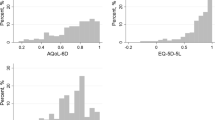Abstract
Introduction: Studies comparing the performance of health-related quality of life instruments in osteoporosis are lacking. We compared the feasibility, validity and reliability of the osteoporosis quality of life questionnaire (OQLQ) and the QUALEFFO (test version) in women with vertebral deformities due to osteoporosis. Methods: Three hundred and thirty-eight patients diagnosed with primary osteoporosis and vertebral deformity and a random sample of 304 women from the general population (control group) were recruited. Patients and controls were randomly assigned to receive either the OQLQ or the QUALEFFO, and the SF-36 and EQ-5D. Test–retest reliability was assessed in the patient group. Results: The QUALEFFO had more items with missing data and took slightly longer to administer (20.7 vs. 18.7 min). Cronbach's α and intraclass correlation coefficient (ICC) values for OQLQ domains (α: 0.75–0.91; ICC: 0.85–0.93) were slightly higher than for the QUALEFFO (α: 0.63–0.90; and ICC: 0.80–0.93). OQLQ and QUALEFFO domain scores correlated as expected with SF-36 and EQ-5D domains. Both questionnaires discriminated between patients and controls though the OQLQ showed slightly better discriminant power. Discussion: The superior performance of the OQLQ in terms of administration time, missing responses, and discriminatory capacity needs to be weighed against the advantages of using a self-administered instrument such as the QUALEFFO. A full comparison also requires data on sensitivity to change.
Similar content being viewed by others
References
Consensus Development Conference. Diagnosis, prophylaxis and treatment of osteoporosis. Am J Med 1993; 94: 646–650.
Jones G, Nguyen T, Sambrook PN, Kelly PJ, Gilbert C, Eisman JA. Systematic fracture incidence in elderly men and women: The Dubbo Osteoporosis Epidemiology Study (DOES). Osteoporosis Int 1994; 4: 277–282.
Díaz-Curiel M, Carrasco JL, Honorato J, Pérez Cano R, Rapado A, Ruiz I. On the behalf of the Multicenter Research Project on Osteoporosis. Study on bone mineral density (BMD) in lumbar spine and femoral neck in Spanish population. Osteoporosis Int 1997; 7: 59–64.
Nevitt MC, Ettinger B, Black DM, et al. The association of radiographically detected vertebral fractures with back pain and function: A prospective study. Ann Int Med 1998; 128: 793–800.
Cook DJ, Guyatt GH, Adachi JD, et al. Quality of life issues in women with vertebral fractures due to osteoporosis. Arthritis Rheum 1993; 36: 750–756.
Lydick E, Itkin Zimmerman S, Yawn B, et al. Development and validation of a discriminative quality of life questionnaire for osteoporosis (The OPTQOL). J Bone Miner Res 1997; 12: 456–463.
Osteoporosis Quality of Life Study Group. Measuring quality of life in women with osteoporosis. Osteoporosis Int 1997; 7: 478–487.
Lips P, Cooper C, Agnusdei D, et al. Quality of life as an outcome in the treatment of osteoporosis: The development of a questionnaire for quality of life by the European foundation for osteoporosis. Osteoporosis Int 1997; 7:36–38.
Lips P, Cooper C, Agnusdei D, et al. Quality of life in patients with vertebral fractures: Validation of the quality of life questionnaire of the European foundation for osteoporosis. Osteoporos Int 1999; 10: 150–160.
Lips P, Agusdei D, Caulin F, et al. The development of a European questionnaire for quality of life in patients with vertebral osteoporosis. Scand J Rheumatol 1996; 103: 84–85.
Badia X, Herdman M. Adaptación transcultural al español de los cuestionarios OQLQ y QUALEFFO para la evaluación de la calidad de vida relacionada con la salud en mujeres con fractura vertebral osteoporótica. Rev Esp Enf Met Oseas 1999; 8: 136–140.
Kanis JA, Melton LJ, Christiansen C, Johnston CC, Khaltaev N. The diagnosis of osteoporosis. J Bone Min Res 1994; 9: 1137–1141.
Genant HK, Wu CY, Van Kujik C, Nevitt MC. Vertebral fracture assessment using a semiquantitative technique. J Bone Miner res 1993; 8: 1137–1148.
Cook DJ, Guyatt GH, Adachi JD, et al. Osteoporosis Quality of Life Questionnaire. Background Information. Guidelines for Administration. Ontario: McMaster University, 1996.
Badia X, Schiaffino A, Alonso J, Herdman M. Using the EuroQol 5D in the Catalan general population: Feasibility and construct validity. Qual Life Res 1998; 7: 311–322.
Alonso J, Prieto L, Antó JM. La versión española del SF-36 Health Survey (Cuestionario de Salud SF-36): Un instrumento para la medida de los resultados clínicos. Med Clin 1995; 104: 771–776.
Weinberger M, Oddone EZ, Samsa GP, Landsman PB. Are health-related quality of life measures affected by the mode of administration? J Clin Epidemiol 1996; 49: 135–140.
Streiner DL, Norman GR. Health measurement scales: A practical guide to their development and use. Oxford: Oxford University Press, 1993.
Hays RD, Anderson R, Revicki D. Psychometric considerations in evaluating health-related quality of life measures. Qual Life Res 1993; 2: 441–449.
Epstein RS, Feng W, Hirsch LJ, Kelly M. Intervention thresholds for the treatment of osteoporosis: Comparison of different approaches to decision-making. Osteoporos Int 1998; (Supp 1): S22–S27.
Ross PD, Ettinger B, Davis JW, Melton LJ, Wasnich RD. Evaluation of adverse health outcomes associated with vertebral fractures. Osteoporsis Int 1991; 1: 134–140.
Oleksik A, Lips P, Dawson A, et al. Health-related quality of life in postmenopausal women with low BMD with or without prevalent vertebral fractures. J Bone Min Res 2000; 15: 1384–1392.
Leidig-Bruckner G, Minne HW, Schlaich C, et al. Clinical grading of spinal osteoporosis: Quality of life components and spinal deformity in women with chronic low back pain and women with vertebral osteoporosis. J Bone Miner Res 1997; 12: 663–675.
O'Neill TW, Felsenberg D, Varlow J, Cooper C, Kanis JA, Silman AJ. The prevalence of vertebral deformity in European men and women: The European Vertebral Osteoporosis Study. J Bone Miner Res 1996; 11: 1010–1018.
Wu AW, Jacobson DL, Berzon RA, et al. The effect of mode of administration on medical outcomes study health ratings and EuroQol scores in AIDS. Qual Life Res 1997; 6: 3–10.
Author information
Authors and Affiliations
Rights and permissions
About this article
Cite this article
Badia, X., Díez-Pérez, A., Alvarez-Sanz, C. et al. Measuring quality of life in women with vertebral fractures due to osteoporosis: A comparison of the OQLQ and QUALEFFO. Qual Life Res 10, 307–317 (2001). https://doi.org/10.1023/A:1012200508847
Issue Date:
DOI: https://doi.org/10.1023/A:1012200508847



